Although upon my arrival in Strasbourg I did not head directly for the historical centre since I wanted to look for a specific shop first, I quickly finished with everything I had in this respect and soon enough I reached the Place Kléber. I don’t know if what I read about it being the most famous square in the city is true, but it is certainly the biggest.
 Place Kléber
Place Kléber
The square got its name after Jean Kléber (1753-1800), the hero of some battles fought at the end of the 18th century, who was killed during Napoleon’s campaign in Egypt, but was born here in Strasbourg. This general was buried in a tomb located underneath his monument at this square.
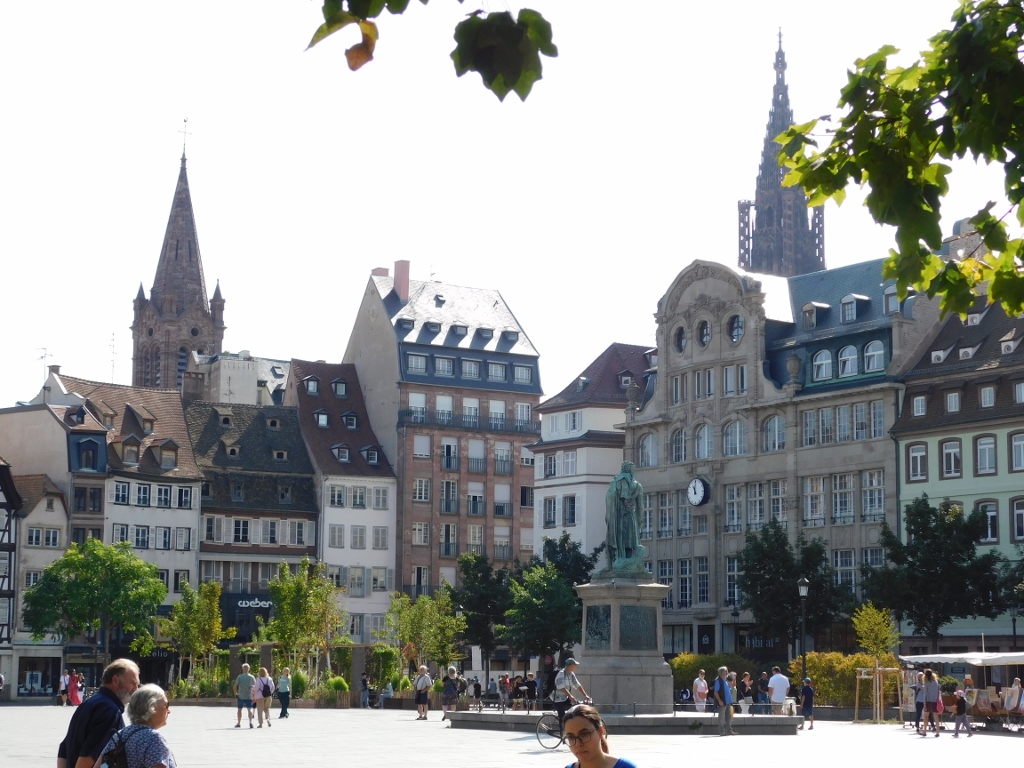 Place Kléber including also the monument to Kléber
Place Kléber including also the monument to Kléber
There is also a historic building, Aubette in the square and it was built in the second half of the 18th century. Earlier, there used to be a monastery complex at this site, but over time some of its parts had collapsed, while the rest was used by the army. Then, in 1765-1772, a new edifice was built in a contemporary French style, but it continued to be used for military purposes. It started to change its purpose in the 19th century, but there was a major fire in 1870 and apart from the facade everything was destroyed and left as it was. It was only during the 1920s that there was restoration, but it is interesting that three abstract artists were engaged to rearrange the interior. The result is quite attractive and today visitors can enter those three rooms and have a look around.
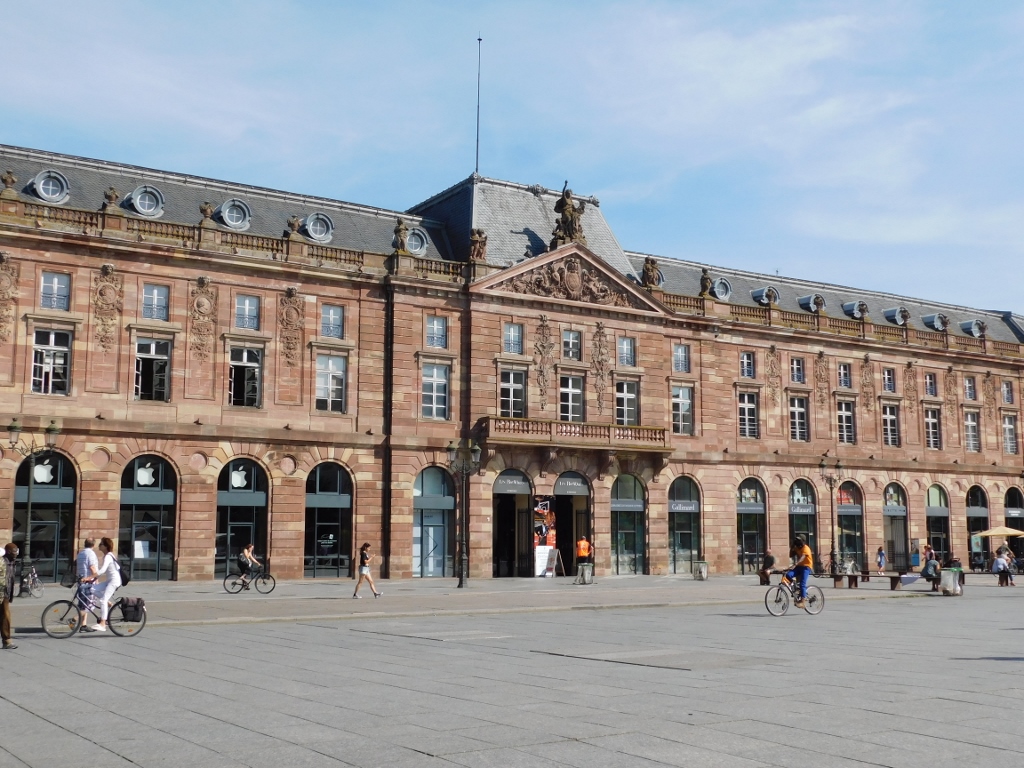 Aubette building in the Place Kléber
Aubette building in the Place Kléber
Let me say straight away that I did not enter here. Strasbourg has so much to offer and the visitor can certainly spend a couple of days here without getting bored. I did not have this much time available. I came with an idea to spend the whole day here, but for different reasons I changed that plan and eventually stayed until the early afternoon. This was not negligible by any means and I used the time efficiently, but that also meant that I did not look at every corner or every room I came across.
Instead, I continued to walk in the direction of the Cathedral of Our Lady of Strasbourg (Cathédrale Notre Dame de Strasbourg) and, as I’ve mentioned, the historic centre of Strasbourg has been in the UNESCO’s World Heritage List since 1988 and this whole part of the city is exceptionally interesting and picturesque.
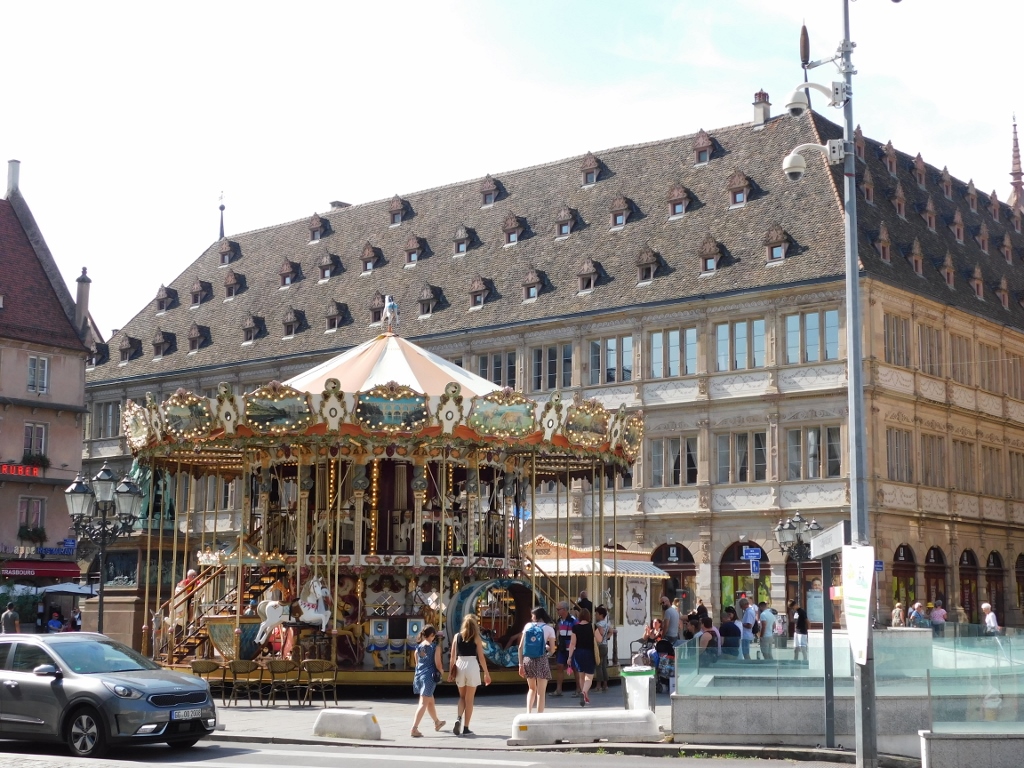 Strasbourg, a detail
Strasbourg, a detail
In 2017, the original property from the List had an addition in the form of the centre of the urban quarter of Neustadt on account of the specific urban planning of that part of the city and some remarkable examples of German Renaissance architecture. As for me, that part of Strasbourg will also have to wait for some future visit of mine. In other words, on this occasion I was interested only in the historic centre. And so soon enough I reached the Cathedral of Our Lady of Strasbourg.
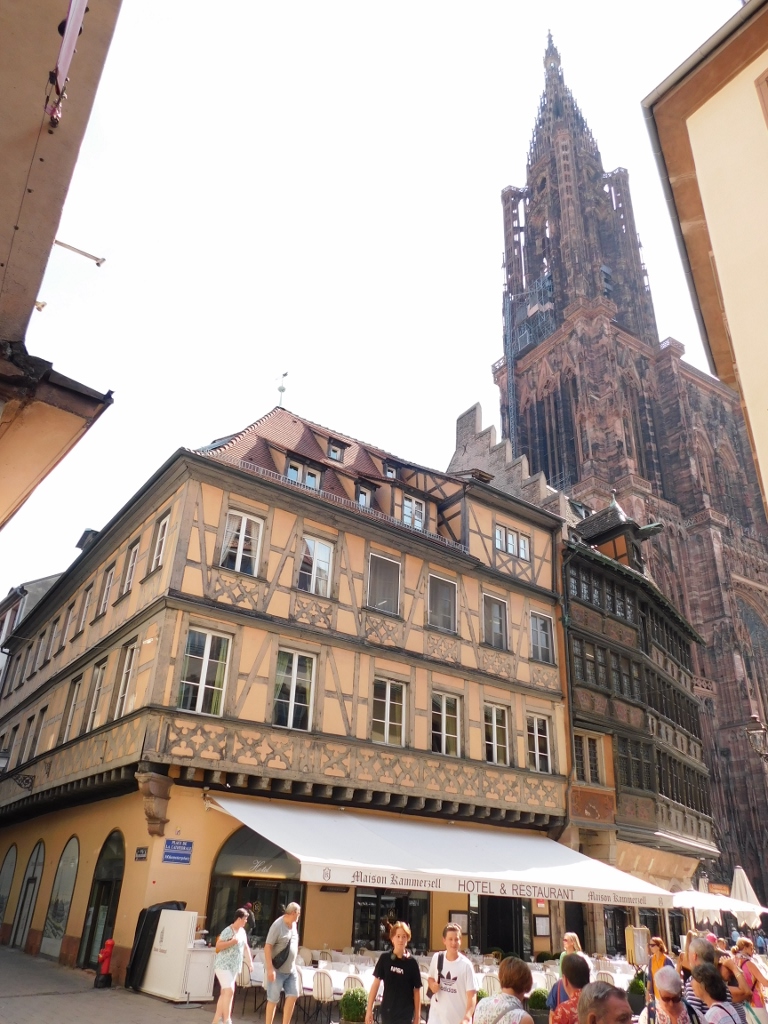 Strasbourg, a detail
Strasbourg, a detail
It is very difficult to come up with a good photograph of the Cathedral, since there are numerous houses quite close to it and it is very high. Still, none of that diminishes the powerful effect of the impressions and details.
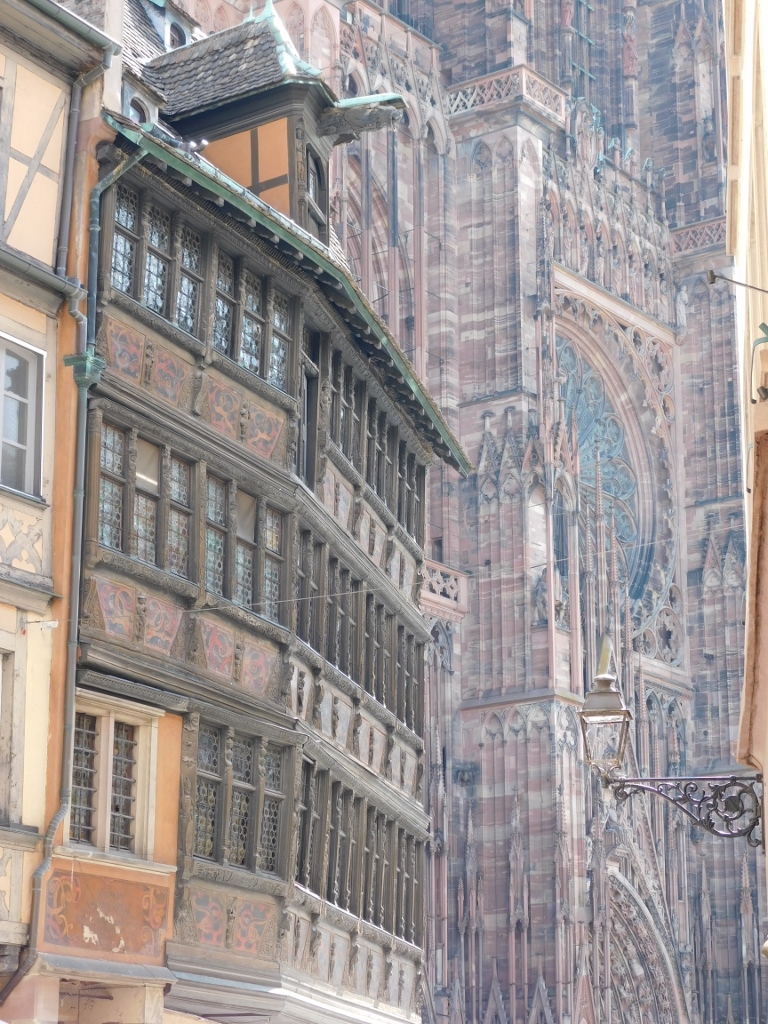 Strasbourg, a detail
Strasbourg, a detail
I approached the Cathedral from the northwest side on purpose in order to pass by the renowned Kammerzell House (Maison Kammerzell) which is one of the most famous houses in the city. A part of its side facade may be seen in the previous photo and this is what the house looks like from the front side:
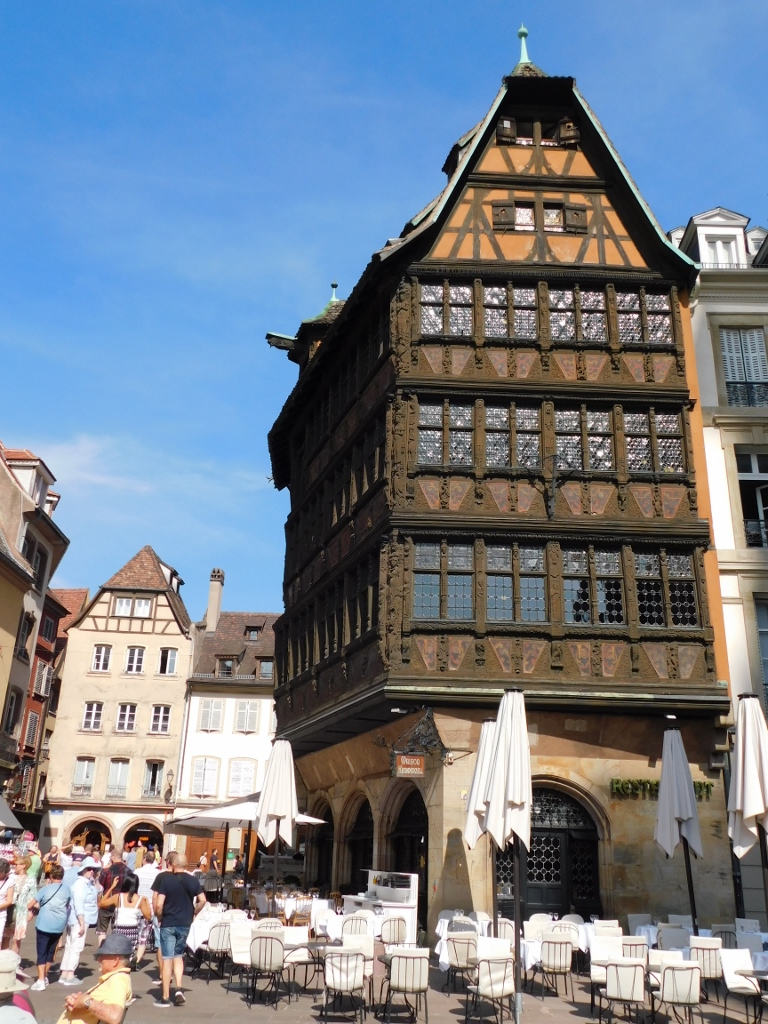 Kammerzell House
Kammerzell House
This house was built in 1427, but it was transformed in the 15th and the 16th centuries, and it is one of the best preserved medieval structures in Strasbourg. It is characterised by exceptionally opulent decoration.
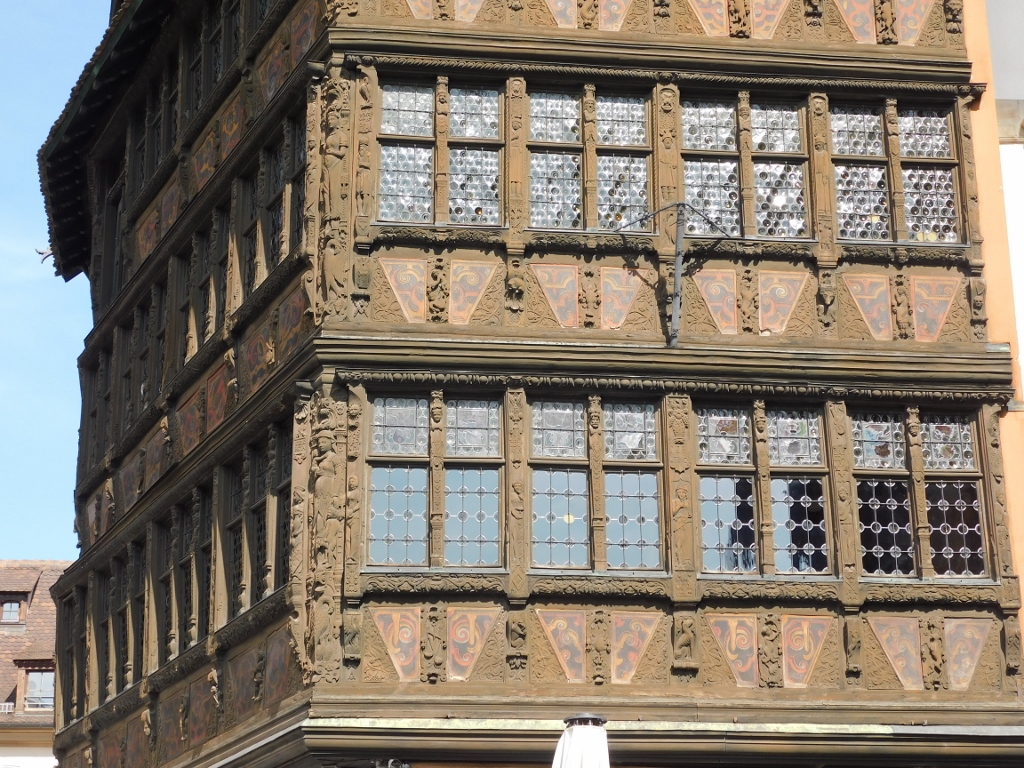 Kammerzell House, a detail
Kammerzell House, a detail
Before dealing with the Cathedral, let me mention that there is another important house at the Cathedral Plaza (Place de la Cathédrale) and this is the Pharmacie du Cerf. This house was first mentioned in 1268 as an apothecary and there are stories that this is the oldest pharmacy in France. In any case, the house in this spot, across the entrance into the Cathedral, was destroyed in fire several times, but it was restored each and every time. It stopped being a medieval apothecary a long time ago, but the house is certainly still very beautiful and picturesque.
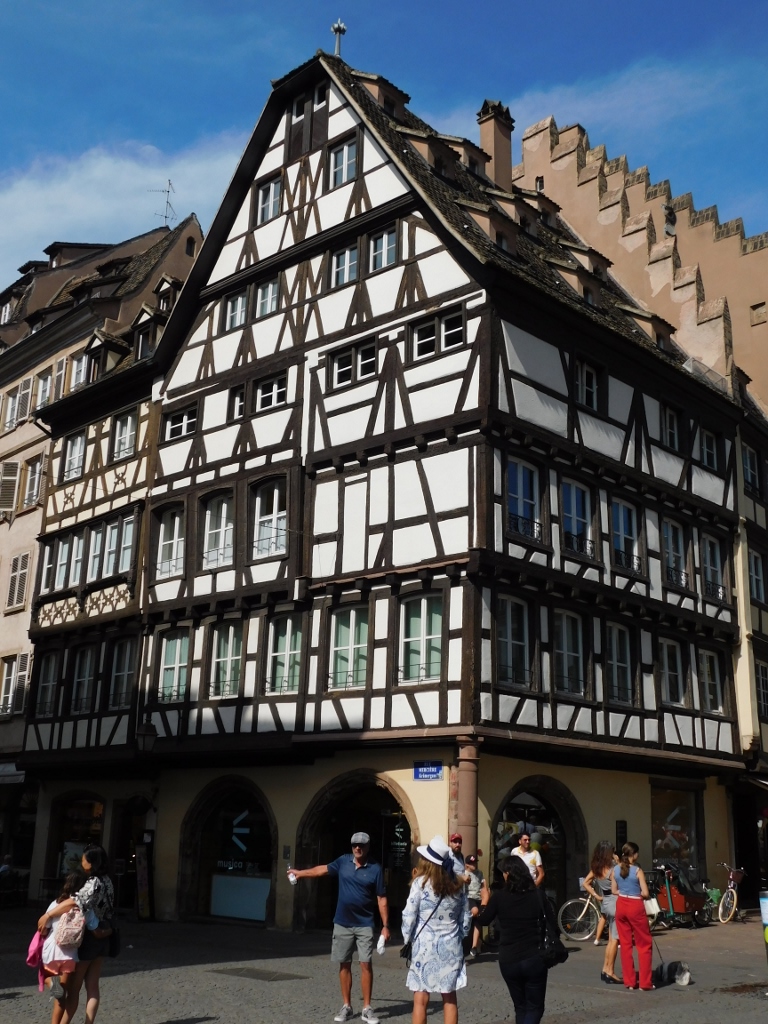 Pharmacie du Cerf
Pharmacie du Cerf
The Pharmacie du Cerf is located on the corner of the Cathedral Plaza and Rue Mercière, and this is the place from which the front facade of the Cathedral can be seen best.
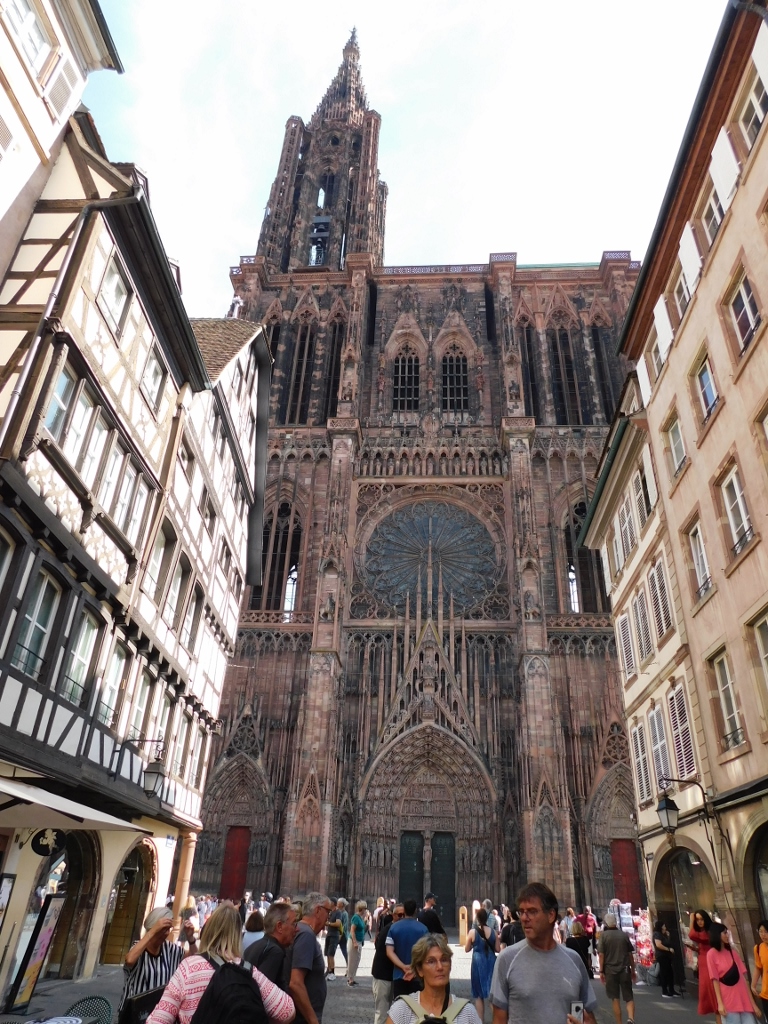 View at the Cathedral from Rue Mercière
View at the Cathedral from Rue Mercière
The first cathedral in this spot was built already in the 6th century, but that edifice was destroyed in a fire in 1002. The ground breaking for the new cathedral took place in 1015, but that Romanesque building was also prone to fires – as many as four major fires were recorded in less than two centuries. Thus, the construction of a new, even more beautiful and bigger cathedral started in 1180 and it lasted until 1439. As for its style, it is a Romanesque-Gothic, since the building has elements of both of them.
Bearing in mind the height of its impressive tower, 142 m, from 1647 until 1874, the Cathedral was the highest building in the world. In addition to the important tower which the visitors may climb today, the Cathedral in Strasbourg also has, in terms of its art, a very renowned west facade.
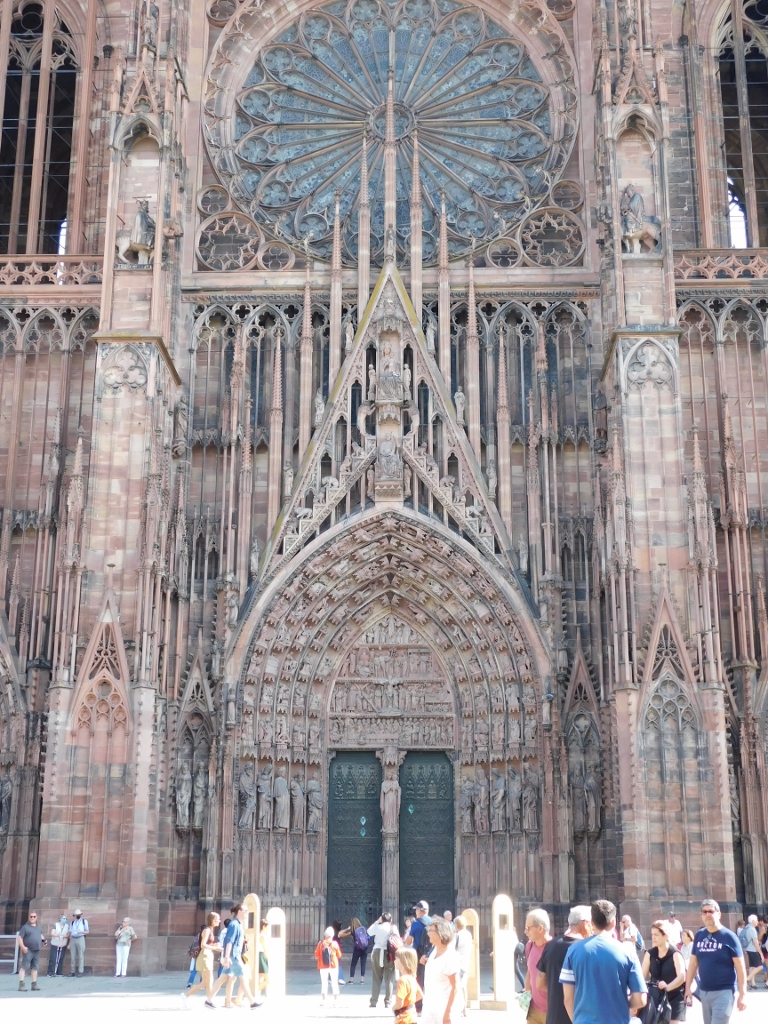 Strasbourg Cathedral, west facade, central portal
Strasbourg Cathedral, west facade, central portal
You can see a huge myriad of decorative elements, whether they are sculptures or low reliefs. Above the central portal, the decorative lancets that come out of its double gable contribute to the general impression of extending upwards, but they also partially hide the rose window above which there is the gallery of the Apostles.
...
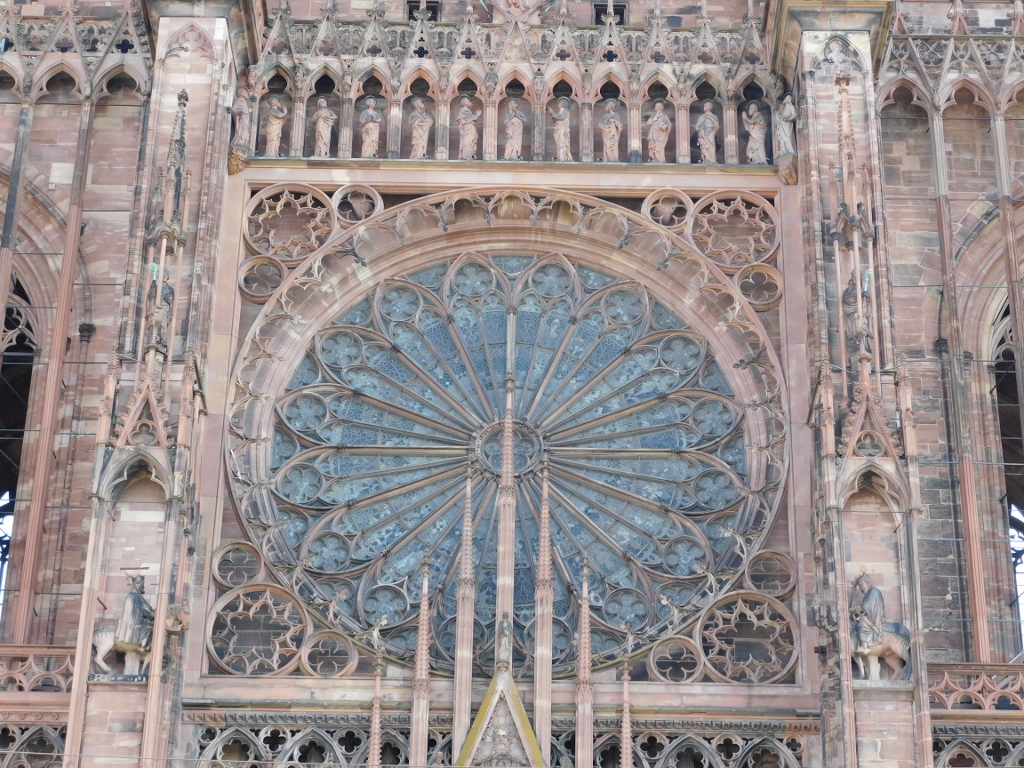 Strasbourg Cathedral, west facade, a detail
Strasbourg Cathedral, west facade, a detail
On the west facade, you can also see three portals that correspond to the interior naves of the church and they are all particularly richly decorated. The decoration of each of the portals deals with a different theme, but they all exhibit exceptionally opulent ornaments.
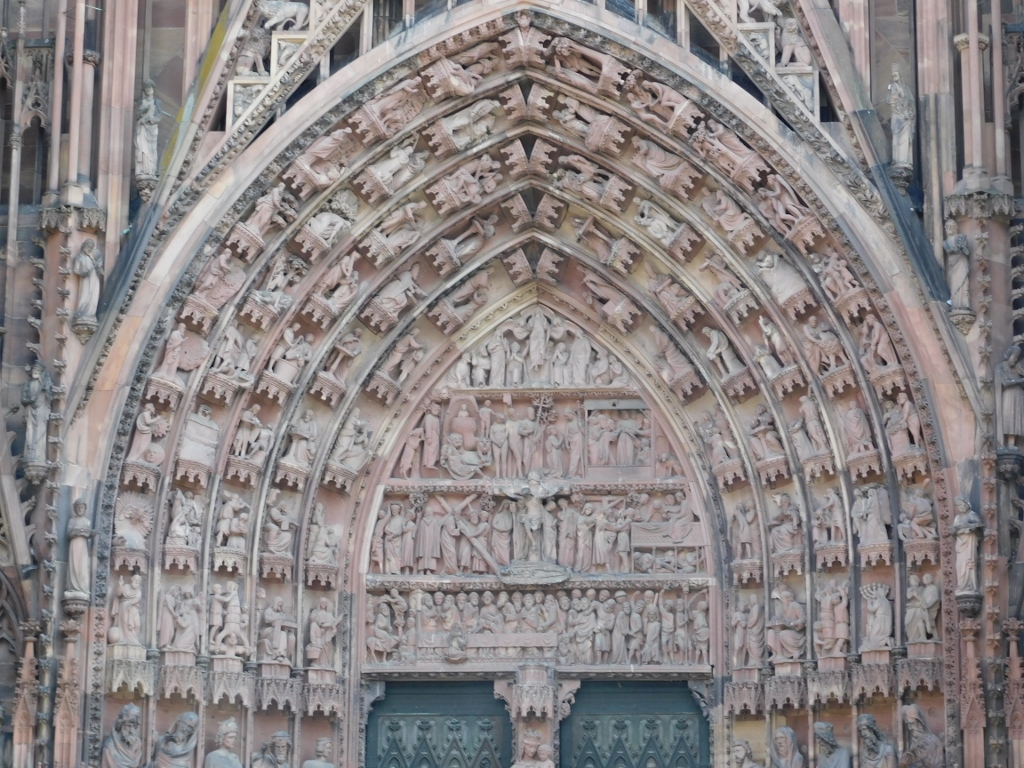 Strasbourg Cathedral, west facade, central portal, a detail
Strasbourg Cathedral, west facade, central portal, a detail
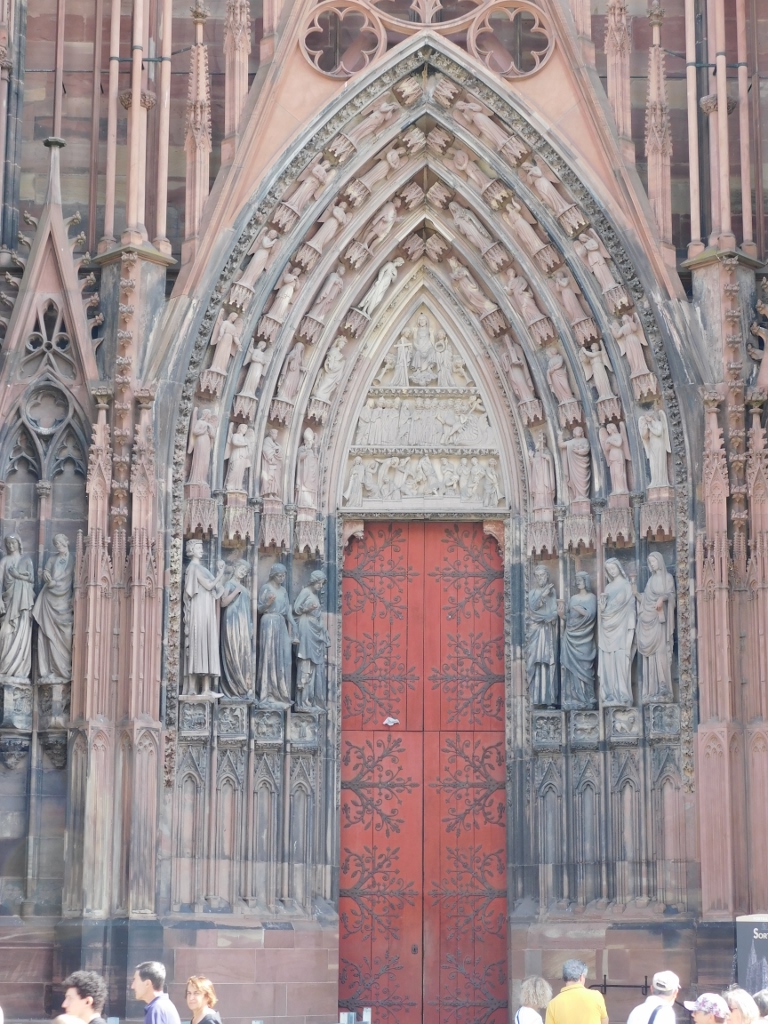 Strasbourg Cathedral, west facade, left portal, a detail
Strasbourg Cathedral, west facade, left portal, a detail
However, when I got to the Cathedral, it was not possible to enter. Like many other visitors who happened to be here at this point in time I was confused, but then I saw some information saying that the Cathedral would be open for visits a little later on. Well, ok, I thought, I could go for a walk and then come back again. To start with I strolled around the Cathedral and was truly impressed by its size. If we today, with all the technological advancement, admire these old buildings because of the architectural and artisanal skills and the size itself, can you imagine how impressed the people were from the times when the Cathedral was first built?
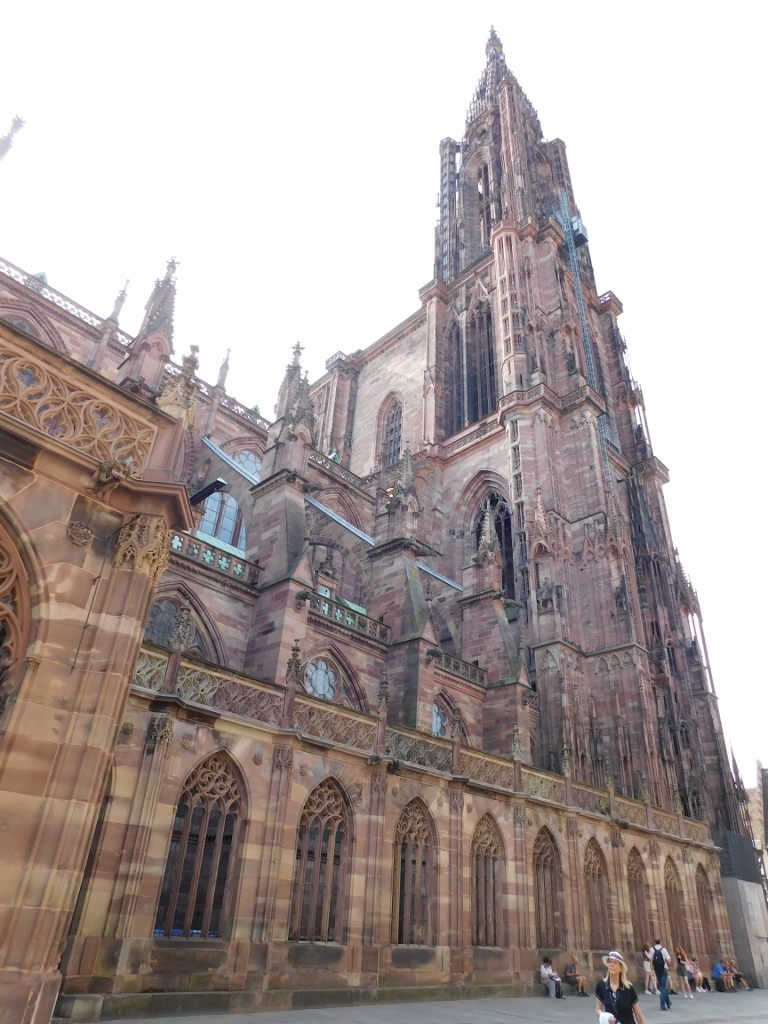 Strasbourg Cathedral
Strasbourg Cathedral
Here in Strasbourg, even the less important buildings in the historic centre were no less pleasant to look at. In addition, as it can be concluded from the photo below, if the visitors want to, they can go for a sightseeing tour of the centre of Strasbourg by a small open train.
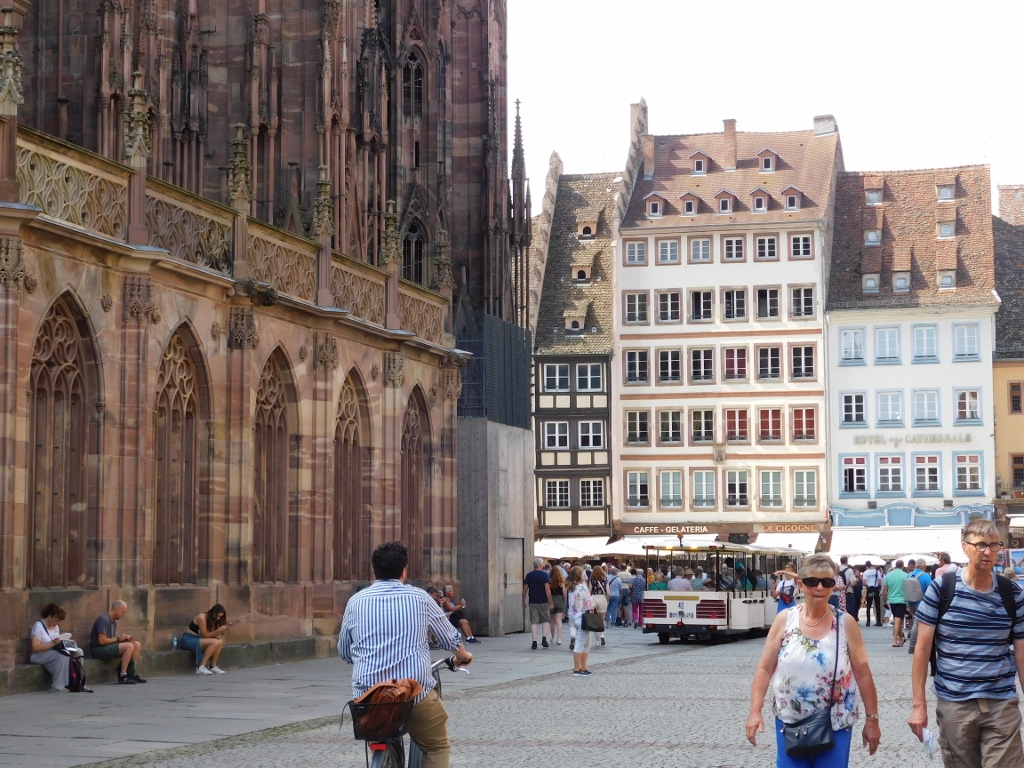 Surroundings of the Strasbourg Cathedral
Surroundings of the Strasbourg Cathedral
I was not interested in the ride by a tourist train, opting rather to walk on along Rue des Frères that is exceptionally picturesque.
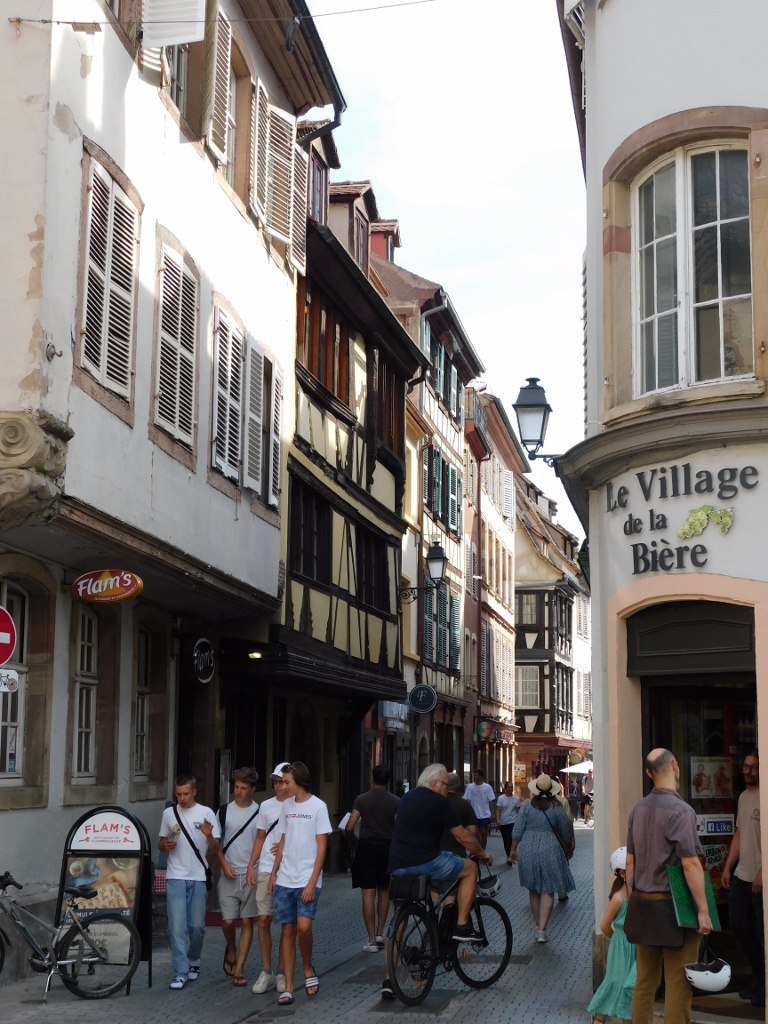 Rue des Frères, a detail
Rue des Frères, a detail
I found the part of this street near a square called La Place du Marché Gayot especially pretty.
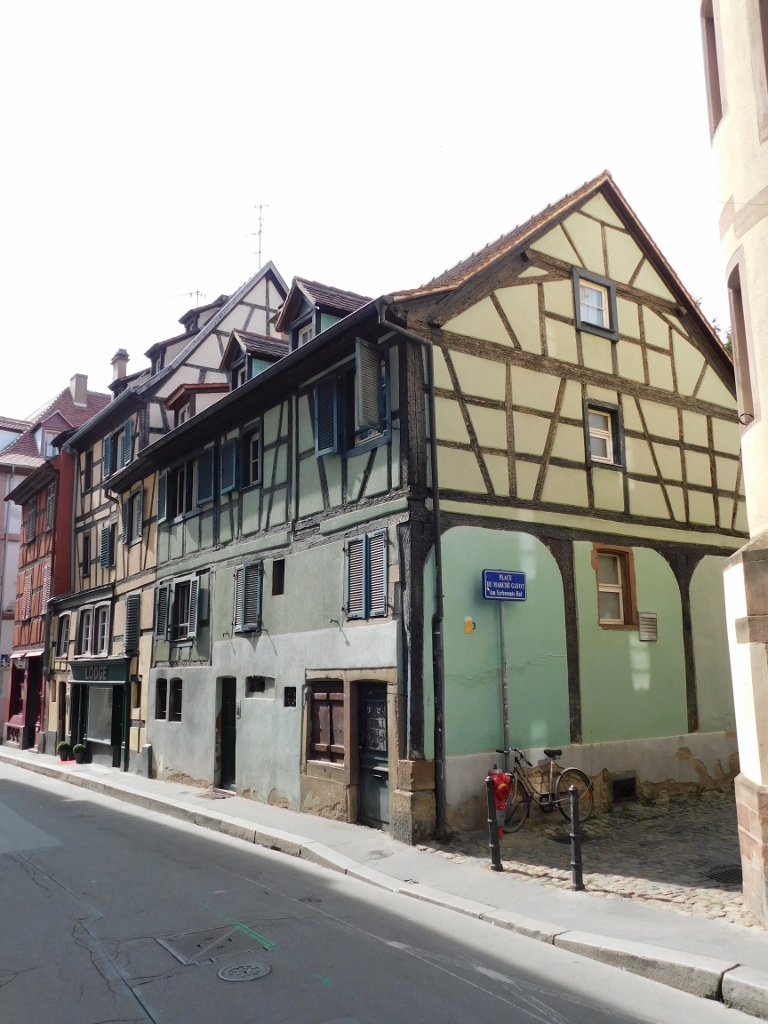 Rue des Frères, a detail
Rue des Frères, a detail
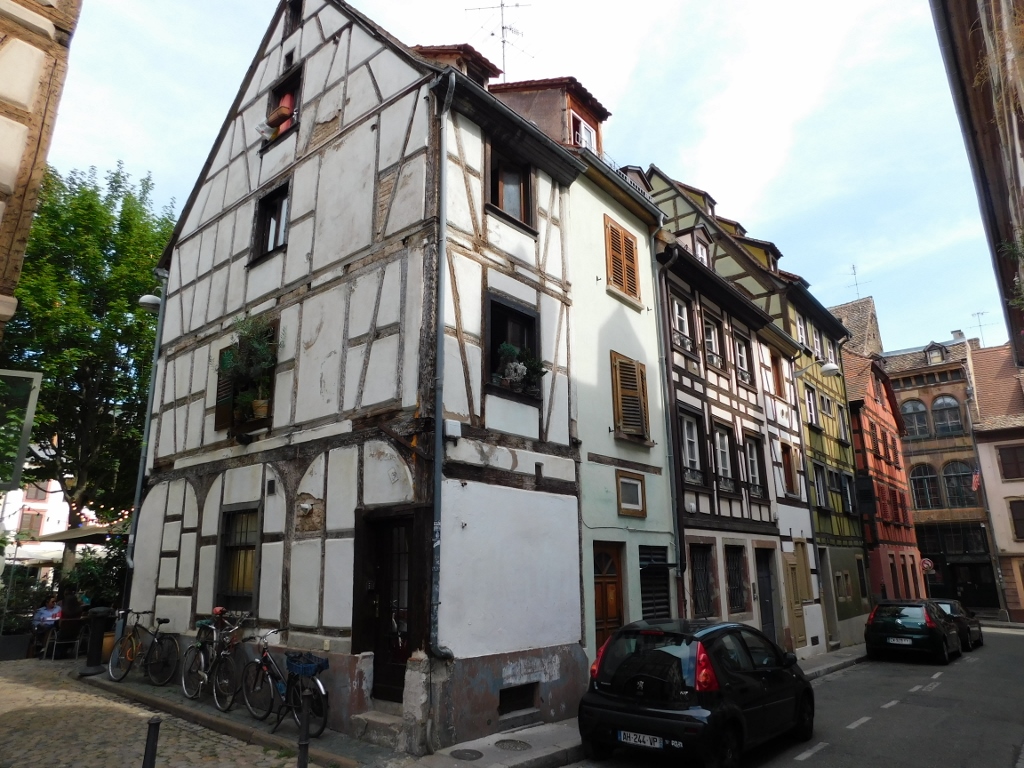 Rue des Frères, a detail
Rue des Frères, a detail
As for La Place du Marché Gayot, this is a smallish rectangular area surrounded by old buildings a couple of storeys high and although it can be reached through as many as eight narrow passages, it can easily be missed by the visitor. The square looks lovely and in addition there are terraces of several restaurants and cafés, which means that this is almost an ideal place to have a break and rest. Especially when the city is being visited in over 30 degrees C.
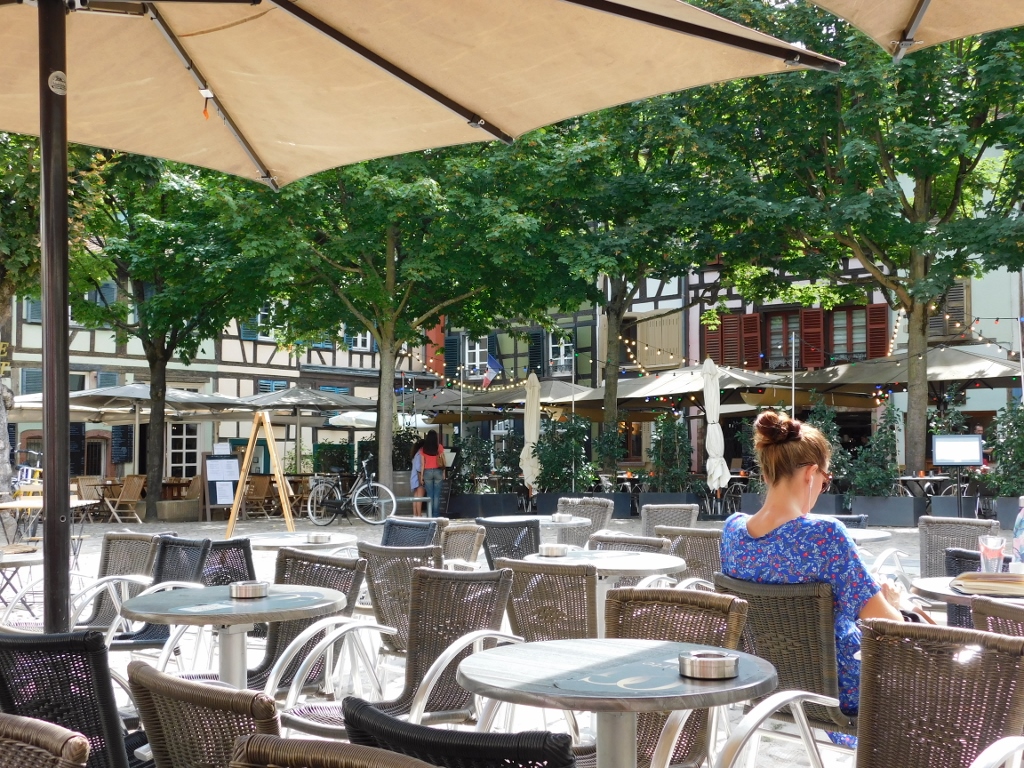 Break at a café at La Place du Marché Gayot
Break at a café at La Place du Marché Gayot
I have already mentioned that my original plan was to spend the entire day in Strasbourg, but that included a visit to some museums. As it turned out, Tuesday is a bad day for the museums in Strasbourg, meaning that they are mostly closed on this day. At least those that I was interested in. Because of this I decided that the visit to the city should come down to a walk and sightseeing of some interesting places just from the outside and that I should spend the afternoon in yet another exceptionally beautiful city that was along the same railway line in relation to Mulhouse as Strasbourg. More about it later.
For now, after the break at La Place du Marché Gayot I walked to the Ill river that is 217 km long and that runs parallel to the Rhine before eventually flowing into it.
 The Ill in Strasbourg
The Ill in Strasbourg
The historic centre of Strasbourg lies on a river island called Grande Île meaning “Big island.” Formally speaking, the island is surrounded by the main course of the Ill on the one side and on the other by a river canal that was originally a natural branch of the Ill and connected its two points. In the Middle Ages, some walls were built on the side of the canal and they were known as the False Rampart, hence the name of the canal that has survived to date – Canal du Faux-Rempart. These ramparts were removed in the first half of the 19th century and today there are numerous passenger boat trips organised around the centre of Strasbourg that sail along the canal and the river.
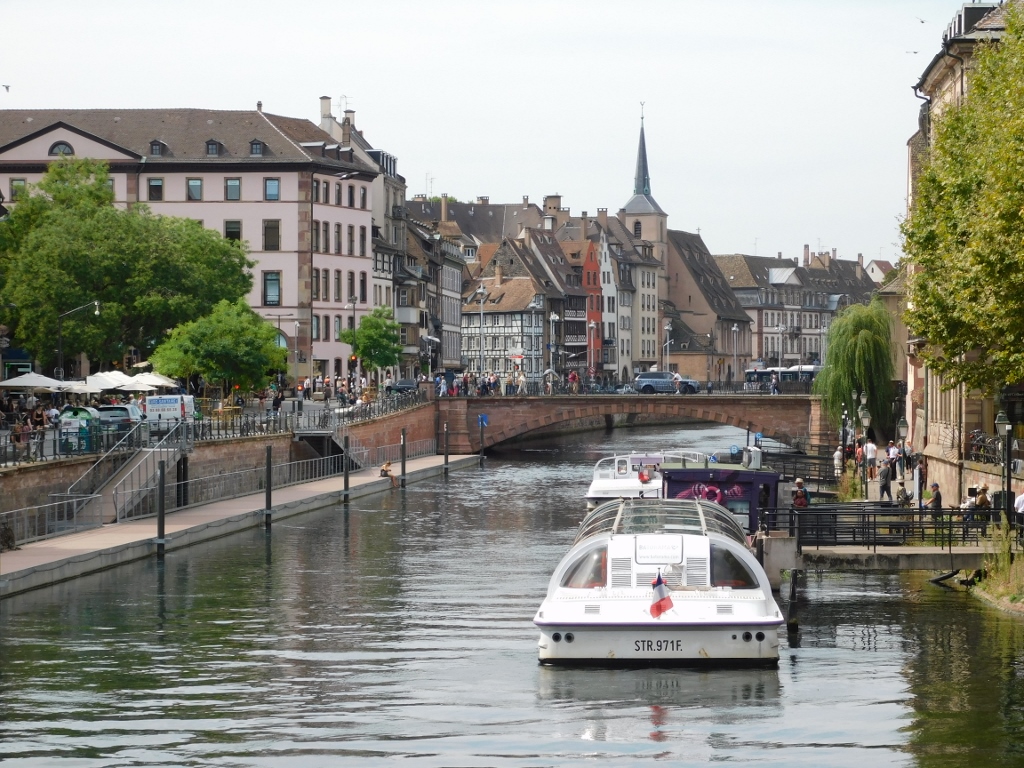 One of the tourist boats for the sightseeing of Strasbourg from the Ill river
One of the tourist boats for the sightseeing of Strasbourg from the Ill river
Bearing in mind the Ill river and the numerous canals that have been made here over time, as well as the fact that the Rhine is less than 5 km away from the historic centre of the city, Strasbourg has always been an important centre for river navigation. Nowadays, the commercial and industrial activities use the port that is the second largest in France and the third largest on the Rhine, while the watercourses around the historical core are mostly used for tourism purposes.
Since I’m talking about Strasbourg in general terms, let me just mention that the name of the city comes from German, meaning the “city of the roads,” precisely because its favourable position made him a proper crossroad of ubiquitous human flows.
There is yet another interesting fact linked to Strasbourg. It was precisely here, during one night in 1792, that the famous La Marseillaise was composed. It was then named “War Song for the Army of the Rhine,” but because it was sung by the volunteers from Marseille as they were marching in Paris it was renamed and since 1795 it has been the anthem of France.
As for Strasbourg at the time of my sightseeing, it was, as I’ve said, the day of closed museums. At least those I was interested in. As for the others, I did not inquire.
For instance, as many as three interesting museums are located in the same building – the Rohan Palace (Palais Rohan). These are the Archaeological Museum, the Museum of Fine Arts and the Museum of Decorative Arts. The Rohan Palace that houses the museums used to belong to the prince-bishops of Strasbourg and it was built in the period from 1732-1742. The most elegant facade of the palace is the one facing the Ill river and that was all of this building and its museums that I saw this time around.
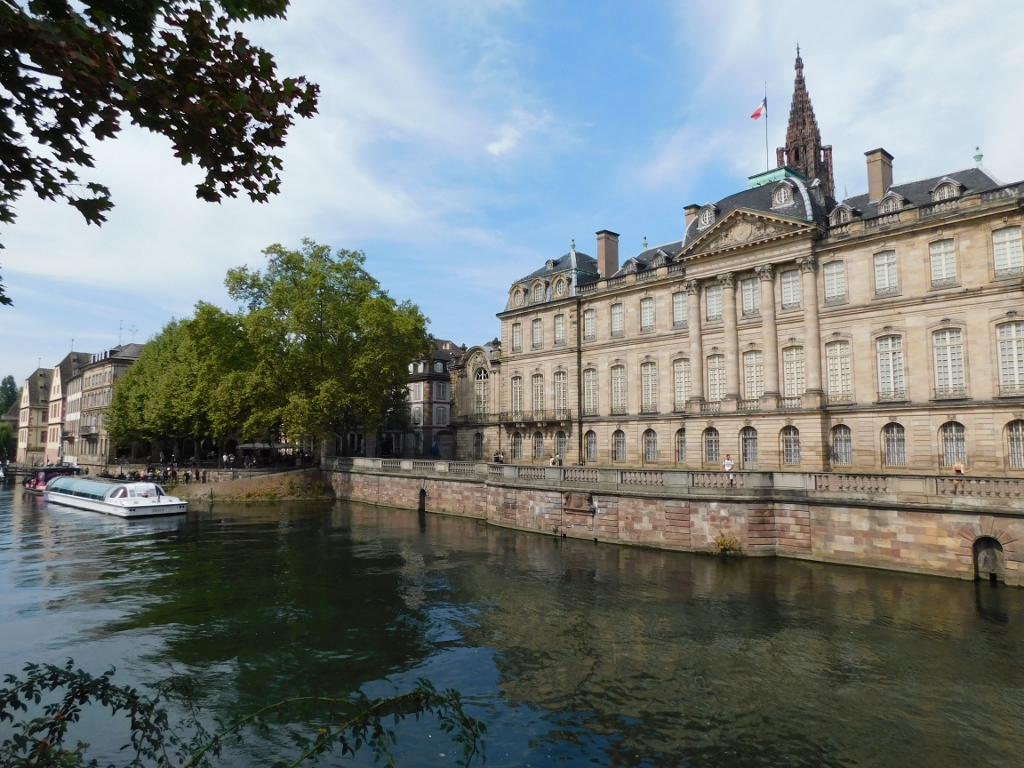 Rohan Palace and the Ill river
Rohan Palace and the Ill river
While walking along the Ill, I could also see nicely some other picturesque details. Some were on the Grande Île and some were on the “dry land.”
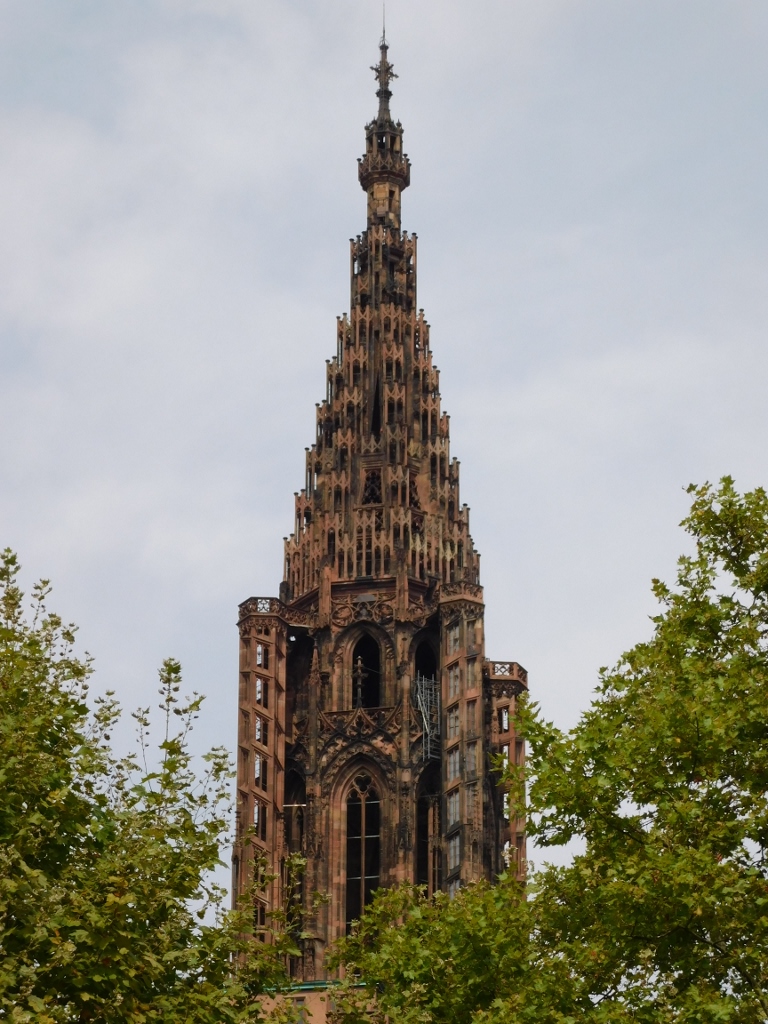 Top of the Strasbourg Cathedral’s tower
Top of the Strasbourg Cathedral’s tower
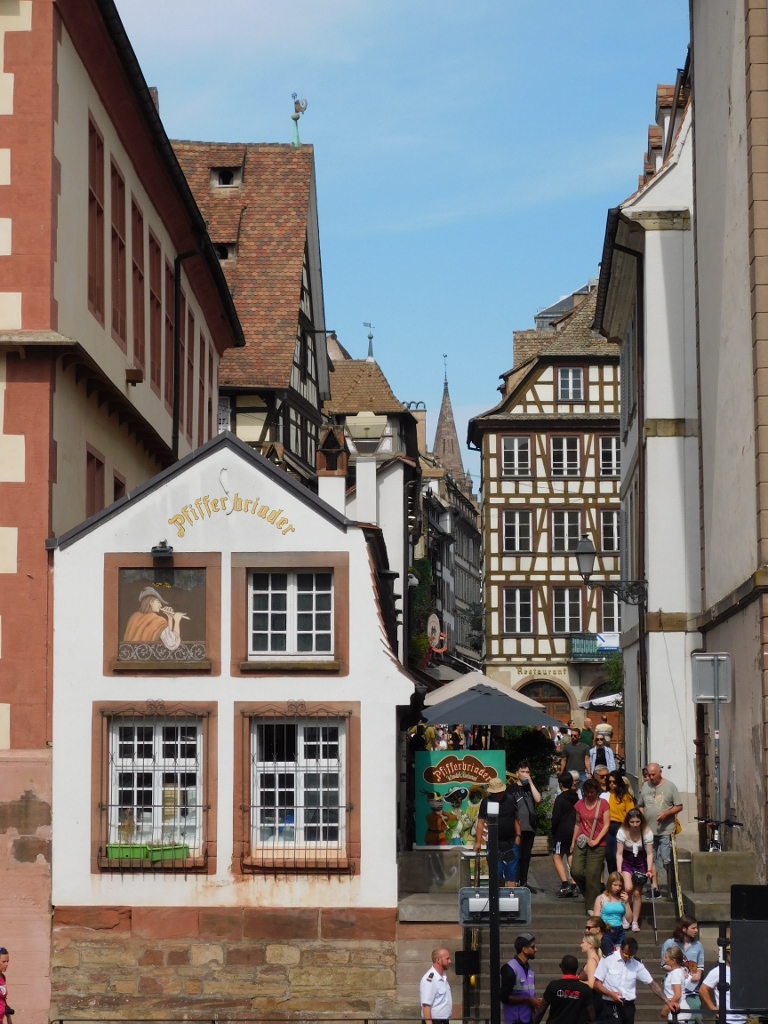 Grande Île, various details
Grande Île, various details
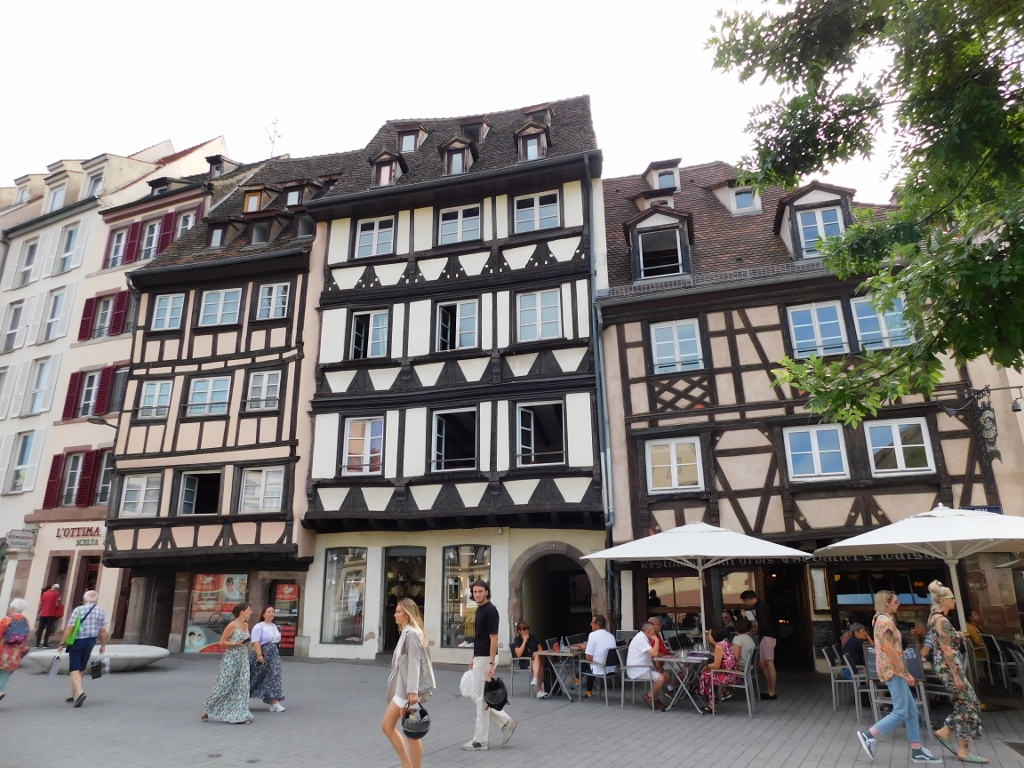 Detail from the promenade along the Ill on the dry land side
Detail from the promenade along the Ill on the dry land side
In one of my guidebooks I came across information that on this side of the Ill, quite close to the place where I was at this point, there is a very nice courtyard linked to an inn/guesthouse from the Middle Ages. According to some data, there used to be a hostelry already from the beginning of the 14th century, but definitely in 1528 a guesthouse was recorded in this spot where over time some historically very well known individuals stayed. The name of the courtyard was made precisely because of that inn that was called “At Raven’s” or corbeau in French, rendering the name to the courtyard – Cour du Corbeau.
This is in fact a line of rather narrow courtyards that extend one next to the other over the length of over 110 m, with buildings from different periods on both sides. In the back of the courtyard, when you enter it through the passage from the Place du Corbeau, there is a hotel and a restaurant nowadays, as a part of the attempts aimed at restoring the original purpose of the 16th-century house, but with full respect for the integrated conservation rules. This is in line with the fact that all the facades and roofs of the houses located in the Cour du Corbeau were categorised as historic monuments already at the beginning of the 20th century.
However, I did not have the exact information about where this courtyard is entered, so eventually I entered the hotel from one of the side streets and the very kind staff directed me to the main entrance/exit that is situated precisely in the back of the courtyard I was looking for.
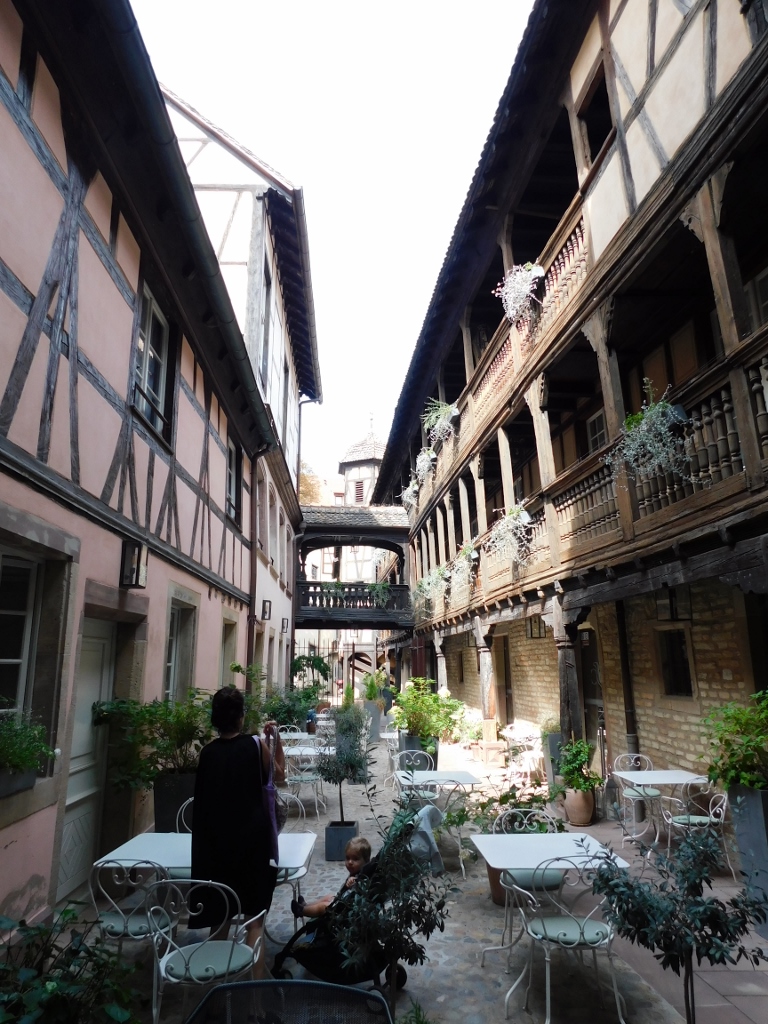 View at the Cour du Corbeau from the doors of the hotel of the same name
View at the Cour du Corbeau from the doors of the hotel of the same name
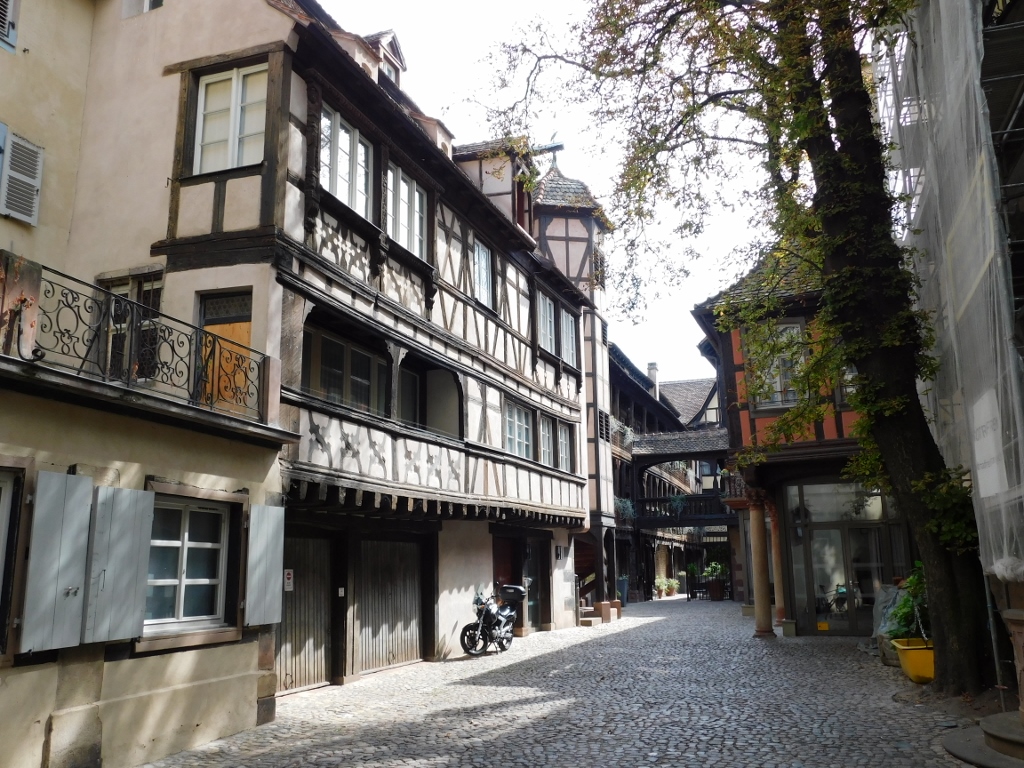 View at the Cour du Corbeau if entered from the “right” side
View at the Cour du Corbeau if entered from the “right” side
So, when I left the courtyard, I exited directly at the Place du Corbeau. Across the square, on the island side of the Ill, you can see the Historical Museum of the City of Strasbourg.
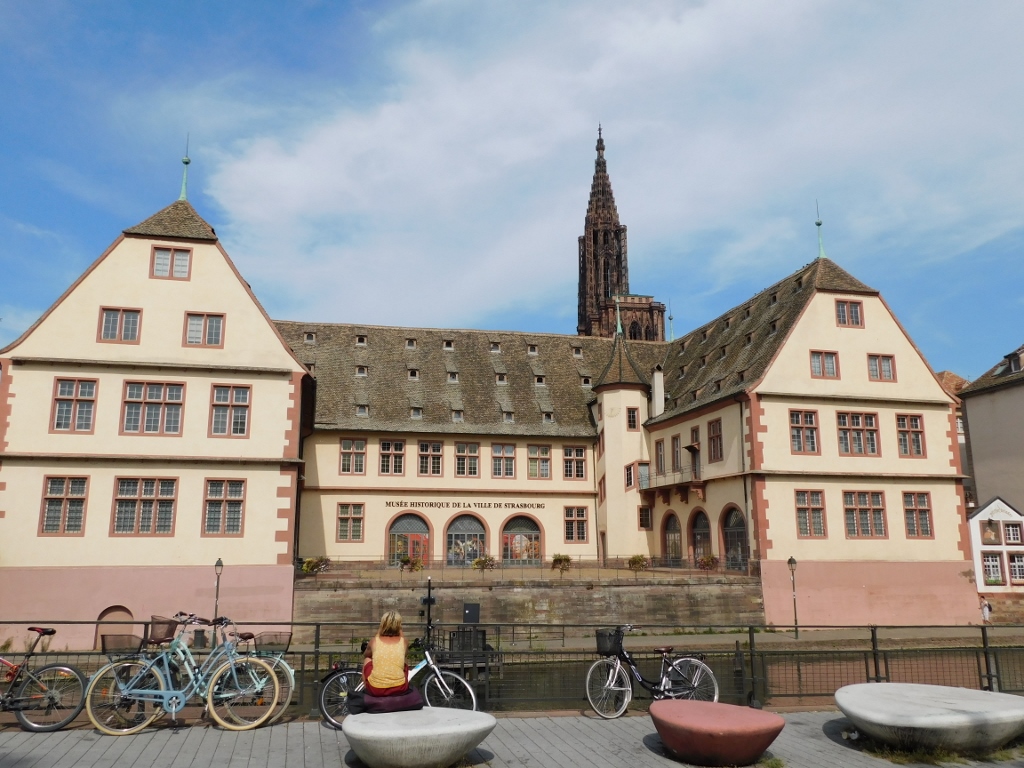 Historical Museum of the City of Strasbourg
Historical Museum of the City of Strasbourg
There is a bridge here as well and I used it in order to return to the Grande Île, i.e., to the historic centre of the city, enjoying along the way the truly pretty sights that are abundant in Strasbourg.
 View from the bridge: Place du Corbeau is to the right, while the Historical Museum of the City of Strasbourg is to the left
View from the bridge: Place du Corbeau is to the right, while the Historical Museum of the City of Strasbourg is to the left
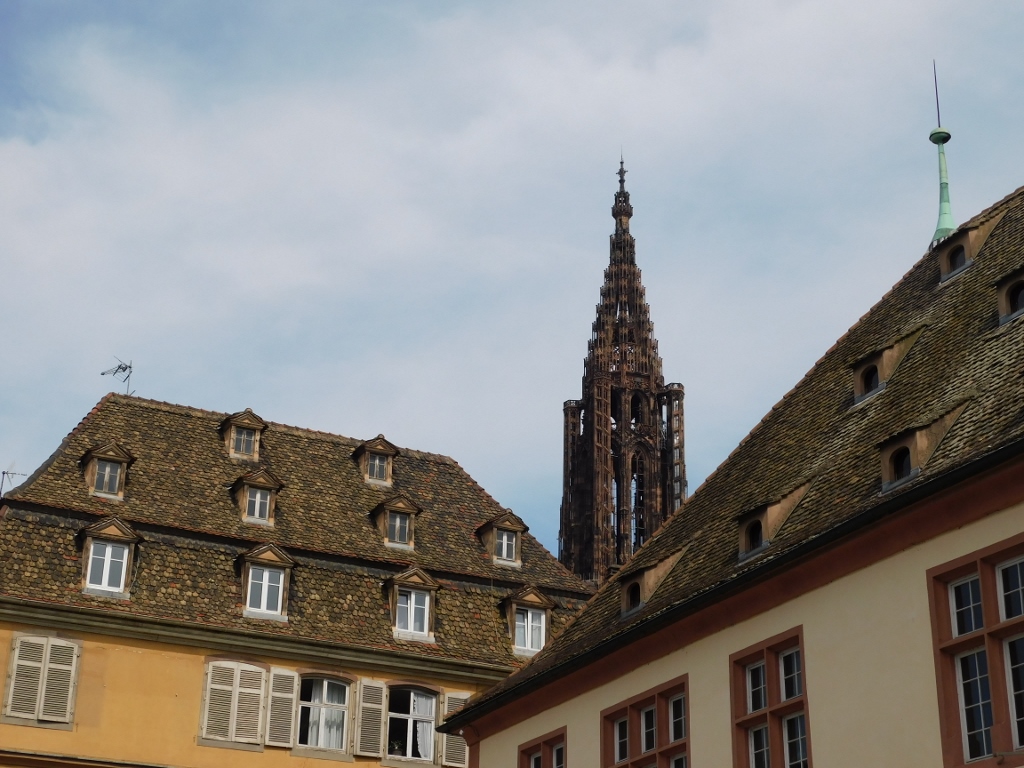 Strasbourg, a detail
Strasbourg, a detail
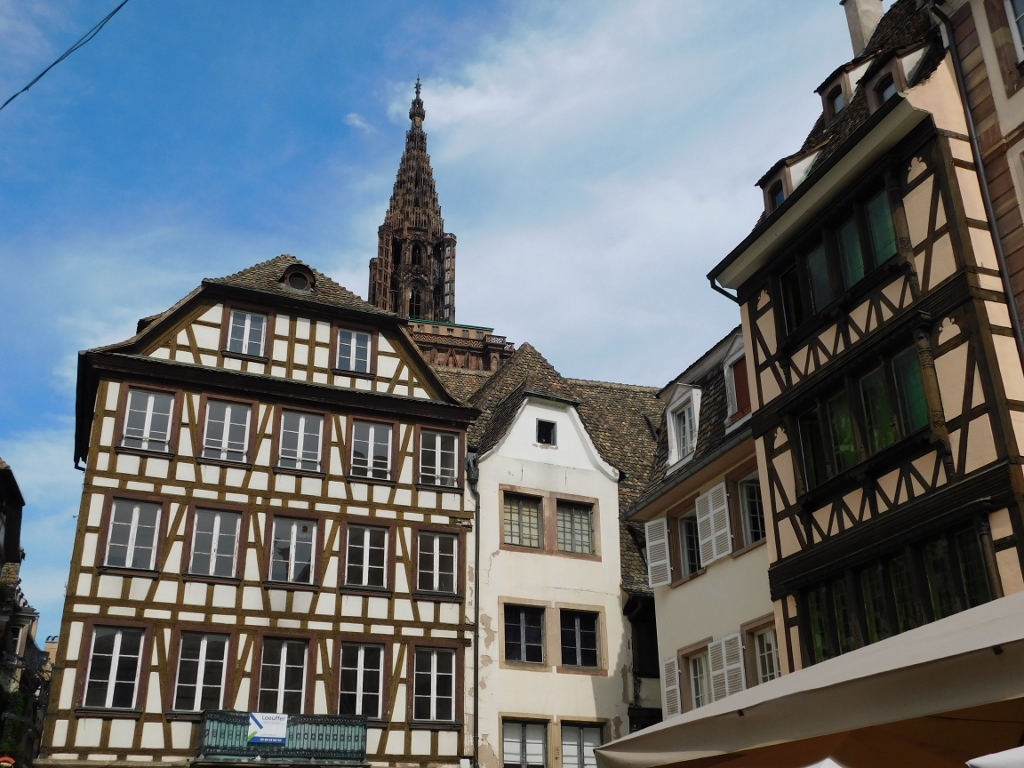 Strasbourg, a detail
Strasbourg, a detail
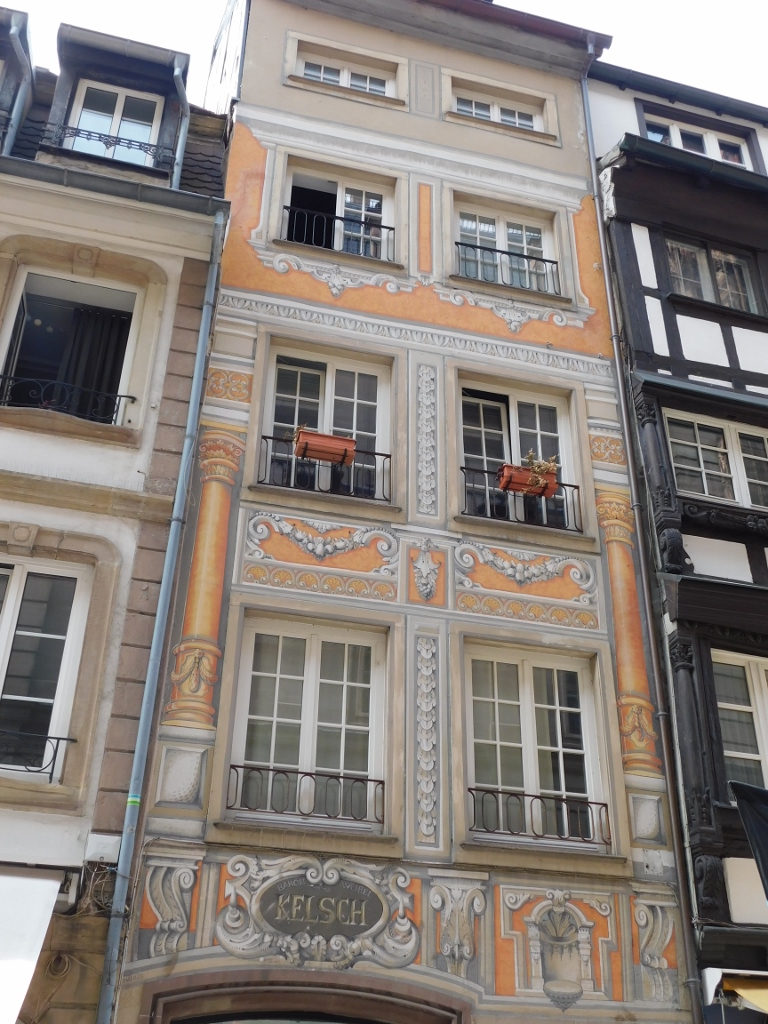 Strasbourg, a detail
Strasbourg, a detail
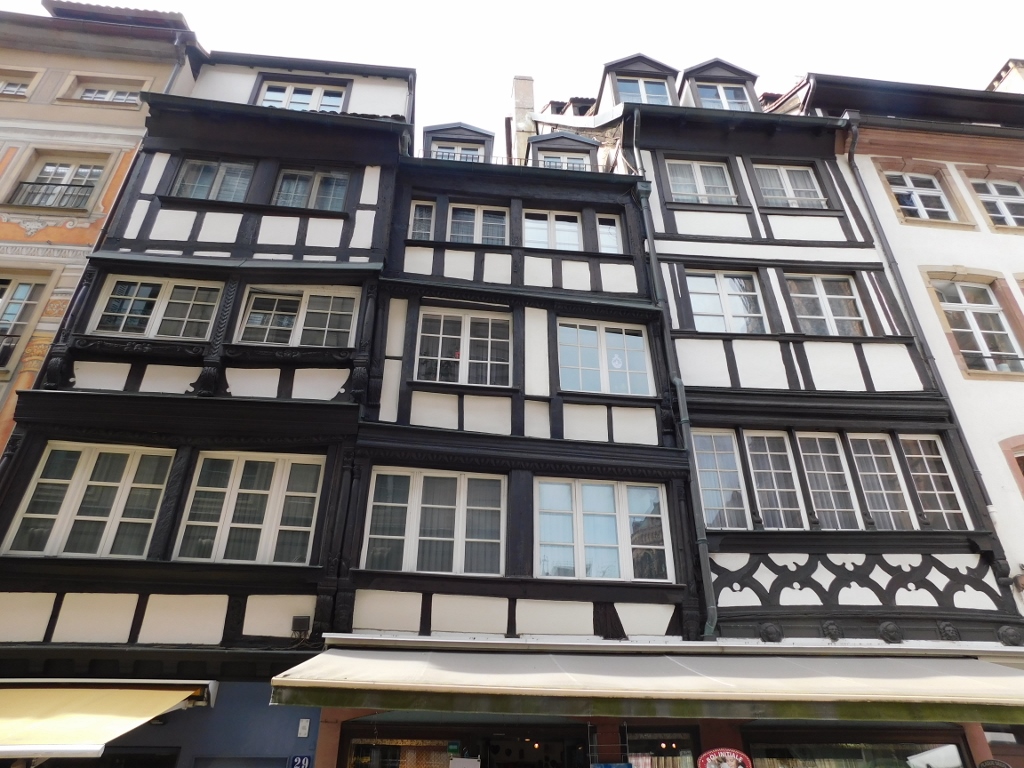 Strasbourg, a detail
Strasbourg, a detail
And then I sat at a restaurant in the centre of the city and ordered a Tarte Flambée, with a couple of additions in comparison to the traditional version.
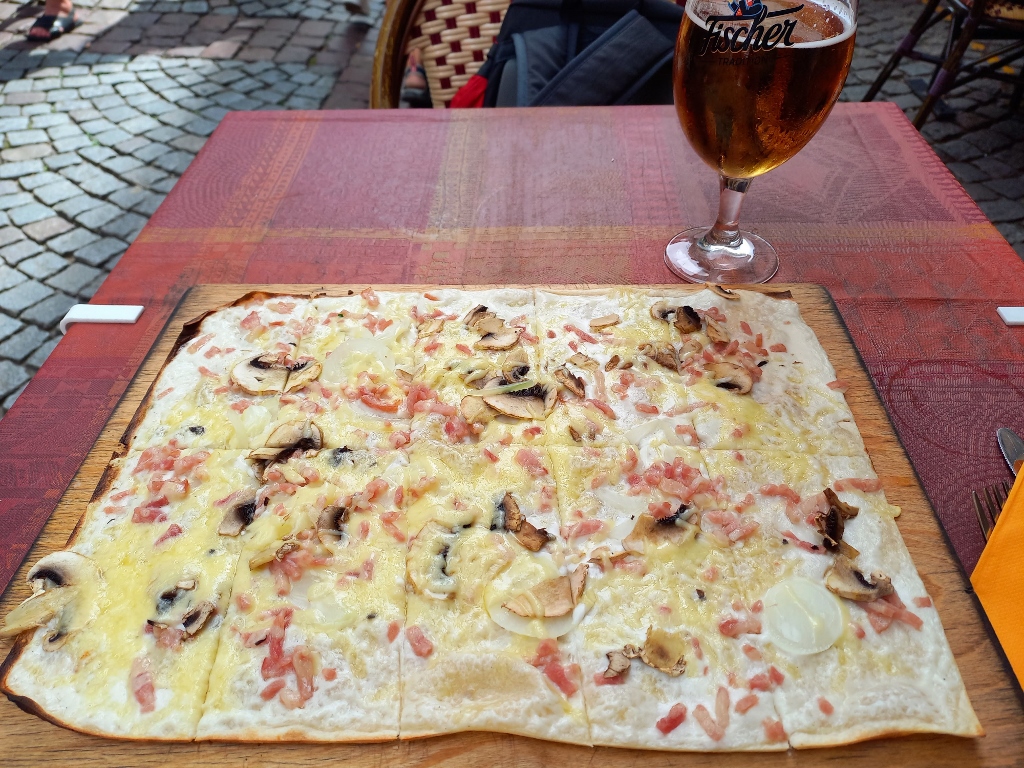 Tarte Flambée in the centre of Strasbourg
Tarte Flambée in the centre of Strasbourg
Needless to say, once back home, I had to try to make my own Tarte Flambée, especially since already before the trip I had found a good recipe for this Alsace specialty. By the way, the dish often appears under its German name – Flammekueche.
As I’ve seen that here in Alsace there are versions with different additions, I decided to make the dough in the original way, but with additions that are basically – Serbian, although reflecting the essence of the original ones. So, here is the result followed by the recipe:
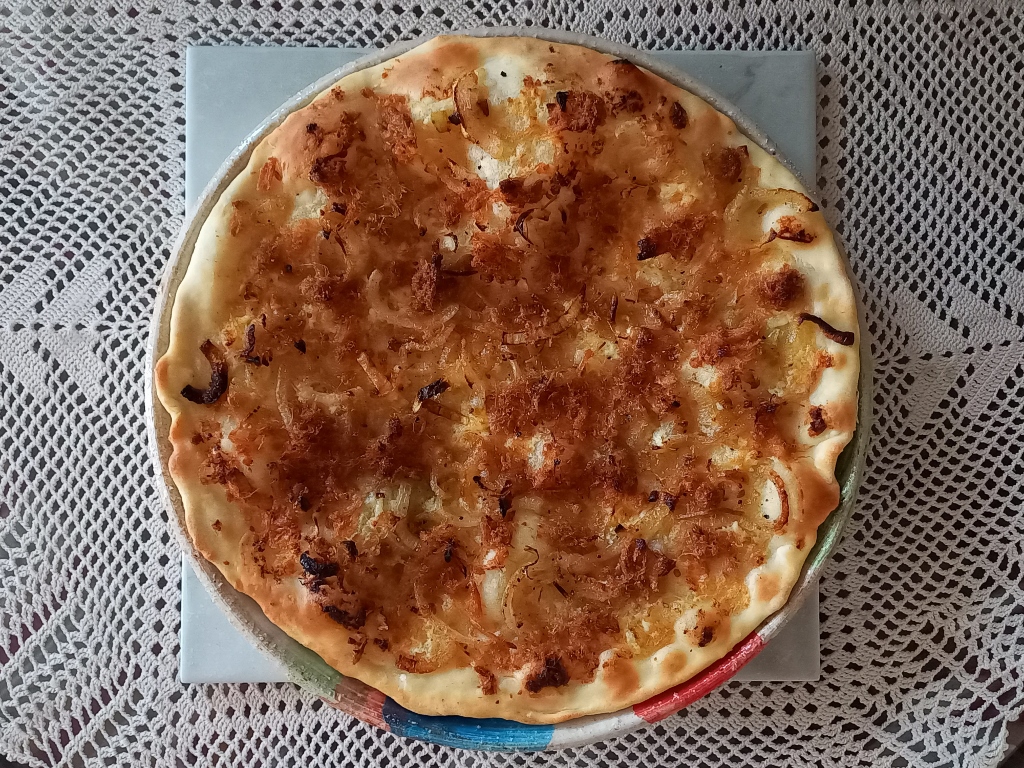 Tarte Flambée à la moi
Tarte Flambée à la moi
TARTE FLAMBÉE, THE SERBIAN WAY
- 140 g all purpose flour
- a pinch of salt
- 2 tbs of oil
- 70 ml water
- 100 g kaymak
- 150 g fine pork cracklings
- 1 onion
- salt and pepper
Make the dough from the flour, salt, oil and water. Bring it together and knead for a few minutes and then leave covered on the side, while you get the onions ready.
Leave the kaymak at room temperature so that it softens a little. Cut the onion in half and then slice it thinly. Then fry the onions using lard and season it with salt and pepper. Once the onions soften and get a nice colour, remove them from the stove.
Spread the dough as thinly as possible, but it must be at least 26 cm in diameter. When you put the dough onto a baking tray it will probably shrink a little, so spread it again using your fingers. Spread the kaymak over the dough and sprinkle over the onions and the pork cracklings. Bake at 220 degrees C for some 10 minutes.
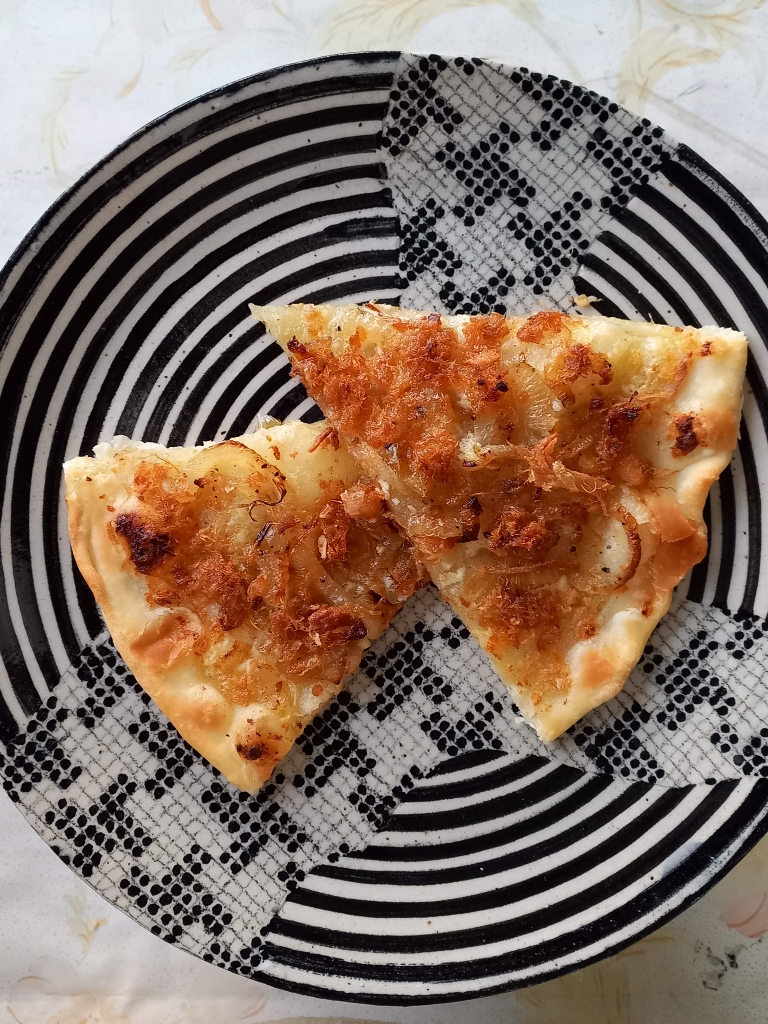 Tarte Flambée à la moi served, of course, in a plate which I also made
Tarte Flambée à la moi served, of course, in a plate which I also made